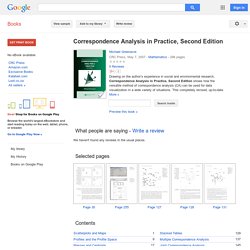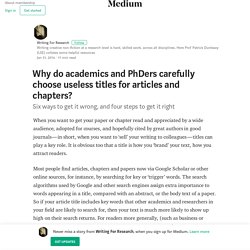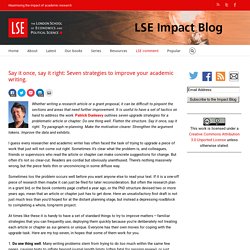

Correspondence Analysis in Practice, Second Edition - Michael Greenacre - Google Books. Drawing on the author’s experience in social and environmental research, Correspondence Analysis in Practice, Second Edition shows how the versatile method of correspondence analysis (CA) can be used for data visualization in a wide variety of situations.

This completely revised, up-to-date edition features a didactic approach with self-contained chapters, extensive marginal notes, informative figure and table captions, and end-of-chapter summaries. New to the Second Edition • Five new chapters on transition and regression relationships, stacked tables, subset correspondence analysis, analysis of square tables, and canonical correspondence analysis • Substantially more figures and tables than the first edition.
Geogly plus biology plus soils. Tacit. Research Methods in Public Administration and Nonprofit Management ... - David E. McNabb. Designed for both students and practitioners, the new edition of this popular text has been thoroughly revised.

How to write paragraphs — Advice for authoring a PhD or academic book. In English the core building blocks of any intellectual or research argument are paragraphs.

Each paragraphs should be a single unit of thought, a discrete package of ideas composed of closely linked sentences. The most generally applicable sequence to follow is — Topic, Body, Tokens, Wrap. The opening ‘topic’ sentence alerts readers to a change of subject and focus, and cues readers (in ‘signpost’ mode) about what the paragraph covers. It should never link backwards to material that came before (linkages are instead always made forward in ‘wrap’ sentences). So be wary of starting paragraphs with linking words (such as ‘However’, ‘Never the less’, ‘Furthermore’), lest they lead you into looking back. Rational, skimming readers do not treat all parts of paragraphs in the same way.
It follows that the beginning and endings of paragraphs should always be the most carefully written materials. Six common paragraph problems. Why do academics and PhDers carefully choose useless titles for articles and chapters? When you want to get your paper or chapter read and appreciated by a wide audience, adopted for courses, and hopefully cited by great authors in good journals — in short, when you want to ‘sell’ your writing to colleagues — titles can play a key role.

It is obvious too that a title is how you ‘brand’ your text, how you attract readers. Most people find articles, chapters and papers now via Google Scholar or other online sources, for instance, by searching for key or ‘trigger’ words. The search algorithms used by Google and other search engines assign extra importance to words appearing in a title, compared with an abstract, or the body text of a paper. So if your article title includes key words that other academics and researchers in your field are likely to search for, then your text is much more likely to show up high on their search returns.
Even after other researchers have found and read your text, titles remain important. Perception and Opinion Research. Resilience and global sustainability.
Say it once, say it right: Seven strategies to improve your academic writing. Whether writing a research article or a grant proposal, it can be difficult to pinpoint the sections and areas that need further improvement.

It is useful to have a set of tactics on hand to address the work. Patrick Dunleavy outlines seven upgrade strategies for a problematic article or chapter: Do one thing well. Flatten the structure. Say it once, say it right. Try paragraph re-planning. I guess every researcher and academic writer has often faced the task of trying to upgrade a piece of work that just will not come out right. Sometimes too the problem occurs well before you want anyone else to read your text. At times like these it is handy to have a set of standard things to try to improve matters — familiar strategies that you can frequently use, deploying them quickly because you’re deliberately not treating each article or chapter as sui generis or unique. 1. 2.
In other fields, length limits are much less — e.g. just 3,000 words for medical journal articles. 3. 4. 5. 6. 7. 30 tips for successful academic research and writing. Choosing something that you are passionately interested in to research is a great first step on the road to successful academic writing but it can be difficult to keep the momentum going.

Deborah Lupton explains how old-fashioned whiteboards and online networking go hand-in-hand, and offers advice for when it is time to just ‘make a start’ or go for a bike ride. As part of preparing for a workshop on academic publishing for early career academics, I jotted down some ideas and tips to share with the group which I thought I would post here. In the process of writing 12 books and over 110 peer-reviewed journal articles and book chapters over a career which has mostly been part-time because of juggling the demands of motherhood with academic work, I have developed some approaches that seem to work well for me. These tips are in no particular order, apart from number 1, which I consider to be the most important of all.
Governance as a Trialogue. RHP homepage - River Health Programme - NAEHMP.
Proposal. Funding.